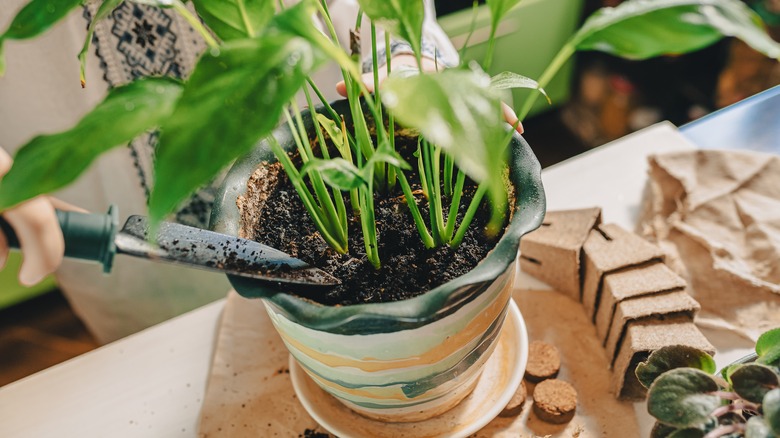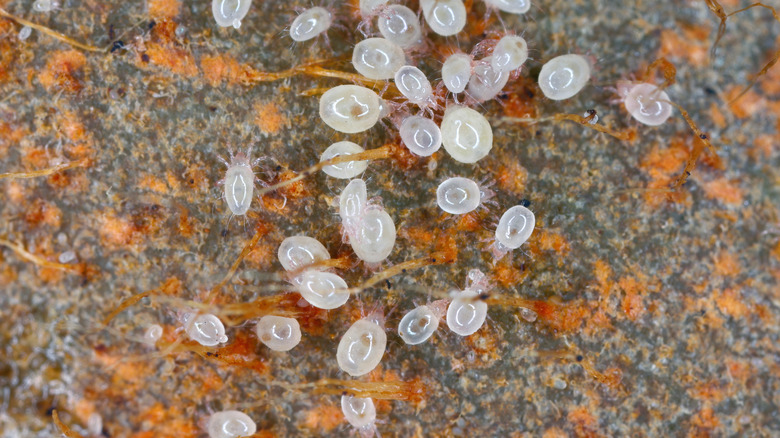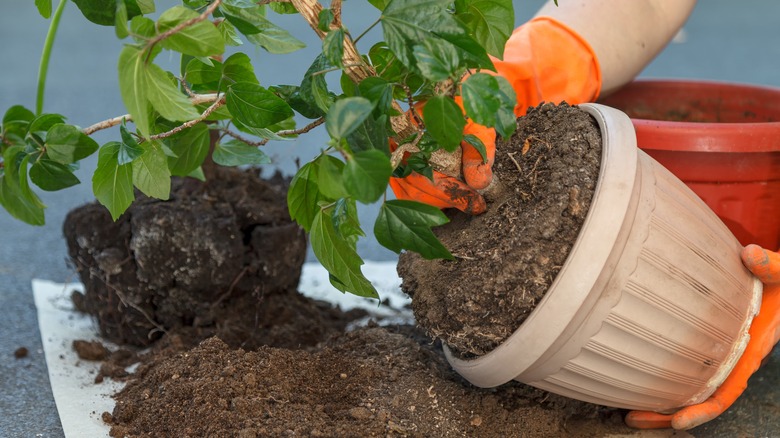Signs Of Soil Mites In Houseplants (And What You Should Do About It)
Do you have a houseplant that benefits from constantly moist soil? Perhaps it's tucked into a somewhat darker area without much sunlight? You may have created the ideal environment for soil mites, which look like very small white insects that move around on top of or just under the surface of the soil. Noticing those moving dots on your houseplant can cause instant alarm, and you may feel the need to take the plant outdoors. Before you do, learn a bit more about soil mites — and why you may not have to do anything about them if you do find them.
Soil mites are a type of pinhead-sized arthropods that are closely related to spiders. If you're seeing them, you could have dozens of them present in the houseplant as they can multiply quickly. Unless your plant shows signs of distress, you may not need any significant treatment for it. If you do have damage, there are several things you can do to keep mites from harming your plants. Your first thought may be, "How could these bugs get into my home?" Typically, soil mites make their way into the home from compost or soil. If you've had the houseplant for some time but added anything to the soil, that's most likely how the mites got into your plant pot. While they don't fly, they can move from one plant to the next if the plants are close together.
How to identify soil mites in your houseplants
Your first step is to determine what tiny critters are crawling around your houseplants. It's easy to confuse soil mites with other types of household plant infestation, especially root aphids. While root aphids can be dangerous to the plant because they actually eat the roots, soil mites are less worrisome. They look like white or sometimes brown dots on the soil. They have a soft body and eat plant pests. Some mites are so small you can barely see them, but they can range in size from 0.1mm to as large as 1 mm. Often, unless you are staring closely at the soil to look for movement, you may mistake soil mites for organic material or fertilizer granules in the soil itself. Any mites larger than this may be a different form, including springtails or root mites.
These pests move through the small pores of the soil, easily making their way throughout the potted plant as they seek out pests to feast on. If you're noticing them, that could indicate a larger infestation, which can be a reason for concern. You may have them and have no idea they are present when they are in low numbers. If you really want to see what's lurking in your houseplant soil, use a magnifying glass or microscope to examine a sampling of the dirt. You may then see hundreds of tiny white dots within the composition that could be soil mites.
What to do about soil mites
Some types of mites can be damaging to the houseplant, but that's not typically the case with soil mites. These tiny arthropods do important work within the houseplant soil, including breaking down the organic matter within the soil and acting as a supportive decomposer that ends up supporting the plants themselves. Their primary source of food is houseplant pests, those that cause damage to plants. That includes nematodes and springtails. Just having soil mites present isn't a problem and shouldn't be a concern for most homes.
It could become a problem if your plant begins to suffer damage from an over-infestation of the pests. You may notice yellowing of the plant's leaves, indicating some stress to the houseplant that needs to be addressed. If you've ruled out other common problems, such as too much standing water, temperature shock, or a lack of nutrients, and you see a lot of soil mites moving around the soil, you can remove some of them.
Do this carefully so as not to further stress the plant. Remove the plant from the pot gently and try to limit how much you disturb the roots. Remove the top two inches of soil present on the plant and discard. Then, replace the soil with new houseplant-appropriate potting mix as you replant it. Choose soil that's appropriate for the type of houseplant you have. Give the plant ample light, proper watering, and good temperature control to help it recover.


